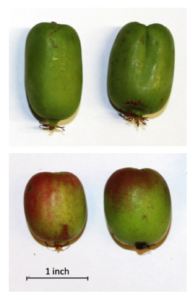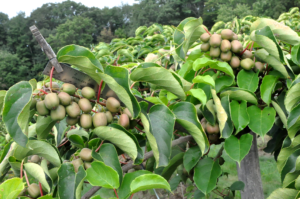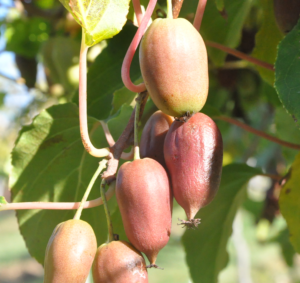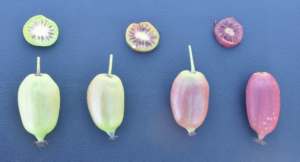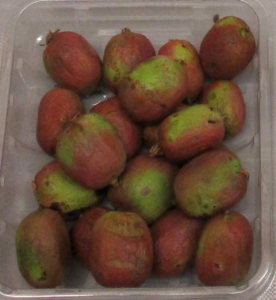Important Traits and Currently Available Commercial Cultivars
Until very recently, a kiwiberry nursery trade in support of field-scale commercial producers, as opposed to backyard growers, has been practically non-existent. Compounding this longstanding lack of affordable, high volume supply has been a fundamental confusion in variety identification even for those vines that are available to the home grower. More than a century of plant material collection and exchange among the USDA, private individuals, and nurseries has resulted in significant levels of mis-labeling and genetic overlap among putatively distinct cultivars.
A cautionary taleDespite being sold under the same cultivar name, available versions of the variety ‘Michigan State’ differ wildly (Fig 13). The original ‘Michigan State’ (sometimes also referred to as ‘MSU’), first propagated by D. Sorensen in 1983 from an ornamental landscaping vine found growing on the Michigan State University campus (R. Guthrie, pers. communication), produces very large, green-skinned, rectangular blocky berries of unremarkable flavor. Within the USDA collection, two different Plant Introductions (PIs) are listed as ‘Michigan State.’ The first, PI617128, appears to match the description of Sorensen’s original submission and is genetically similar to two other varieties marketed under the names ‘Jumbo’ and ‘Chico’ (Melo et al. 2017). The second, PI617136, produces smaller, red-blushed berries with superior flavor and quality characteristics and is genetically similar to one of the two USDA accessions bearing the label ’74-49,’ one of the 14 historic USDA accessions labeled ‘Ananasnaja’ (or variations on the spelling), and the variety ‘Rossana’ marketed by the private nursery One Green World. In the first version of this online guide, to draw a distinction between these two varieties, we had referred to USDA PI617136, one of our originally recommended varieties for the region, as ‘Michigan State – small fruit variant (SFV)’ (Table 3). Since that time, further genetic analysis revealed the fact that PI617136 is actually the popular variety better known as ‘Ananasnaya’ (a.k.a. ‘Ananasnaja’, ‘Anna,’ and ‘Ana’). Of the nurseries listed in Appendix 1 ‘Grower Resources’, only Hartmann’s Plant Company included “PI617136” in their records for ‘Ana’/‘Ananasnaja’ (formerly ‘Michigan State’) ; and based on the photos available from other nurseries, it is evident that if a grower were to purchase vines from unverified sources, the outcomes could be quite different depending on the nursery source. Even the USDA’s pedigree information for PI617136 is incorrect, as it reads: “Female selection of a cross of A. arguta × A. kolomikta.” This sort of error is reminiscent of V.A. Evreinoff’s 1949 assertion that ‘Ananasnaya’ was an interspecific cross of A. arguta x A. kolomikta, when I. Mitchurin’s original ‘Ananasnaya’ was actually an A. kolomikta selection. The “‘Michigan State’-‘Ananasnaja’ mix-up” is but one (not uncommon) example of a Not True-to-Type Dilemma that has the potential to stymie the incipient US kiwiberry industry unless the matter is addressed for all major named varieties. When it comes to kiwiberry, the current North American nursery trade is a bit of a mess and growers should beware. |
A problem solved One of the first research objectives achieved by the NHAES kiwiberry program was the genetic de-convolution of the North American collection of varieties, with the intent of characterizing existing diversity and establishing a baseline for future improvement (Melo et al. 2017). By revealing widespread misidentification and inconsistent labeling of varieties among nurseries, this work made it clear that a system of nursery stock certification is urgently needed if the commercial kiwiberry sector is to develop. Such certification is critical not only for producers who need to source proven varieties with confidence but also for achieving product uniformity among consumers. To address this practical need, we worked closely with Hartmann’s Plant Company to genetically verify the identities of our recommended commercial varieties (Table 3) within their inventory. When sourcing vines, be sure to look for the UNH-verified logo on the Hartmann’s site.
Table 3 Observations made on currently recommended commercial cultivars at the NHAES (USDA Plant Hardiness Zone 5b). Reported dates are averages from the 2018 – 2020 growing seasons. Variety identities are based on molecular genotyping, and each variety name is followed by either its associated USDA plant introduction (PI) number or the initials of its non-USDA source (Melo et al. 2017). TBF = Tripple Brook Farm; KHF = Kiwi Hill Farm. While breeding for the next generation of improved varieties is underway, these existing cultivars are well-suited for regional production; and genetically-verified vines can now be sourced with confidence from Hartmann’s Plant Company. Bud emergence and flowering dates are presented for ‘Geneva 3’. All phenology dates for other cultivars are expressed relative to those for ‘Geneva 3’ [i.e. as days prior to (-) or following (+) those for ‘Geneva 3’).
| Commercially Recommended Female Varieties | |||||
| Variety | Description | Vegetative Budbreak | Flowering Begins | Flowering Ends | Harvest Window |
| Geneva 3 (PI 617133) |
Medium sized, oblong round fruits with moderate brownish-red blush (Fig. 13.1). Berries grow in dense clusters and vines exhibit excellent lateral renewal and vigor. Productive, with excellent sweet-tart flavor and superior storability. | April 21 | June 14 | June 19 | Mid-Sept to early Oct |
| Hardy Red (PI 617107) |
A selection by the great New Zealand horticulturalist Ken Nobbs, ‘Hardy Red’ is one of the only red-fleshed cultivars available with exceptional eating quality and reliable cold hardiness (Fig. 13.2). An interspecific hybrid with A. melanandra, ‘Hardy Red’ produces elongated, torpedo-shaped fruits that turn from all green to a deep crimson red as they reach peak ripeness (i.e. obvious ripeness indicator). Extended harvest possibilities for U-pick operations. | -1 | -1 | -1 | Mid-Sept (storage, +7) to mid-Oct (U-pick, +20) |
| Commercially Recommended Male Varieties | |||||
| Meader Male (TBF) |
A reliable, well-timed, and commonly sold male, originally selected by NHAES researcher Elwyn Meader in the 1970’s. | -1 | 0 | +2 | |
| 74-46 (TBF) |
Listed in the GRIN database as “Meader – Paul Klassen” (PI 617129) but likely part of the 74-series selected in the mid-1970’s by Robert Smith at the USDA Plant Introduction Station in Chico, CA. This reliable and well-timed male is marketed as cv. ‘Clark’ by Hartmann’s Nursery, after Col. William S. Clark, the person to first import A. arguta germplasm into the US (1876). | -4 | 0 | +3 | |
| 74-52 (KHF) |
Also part of the Chico station 74-series but with a slightly later flowering window. Sold as ‘Fairchild’ by Hartmann’s Nursery, after the renown USDA plant explorer and tireless Actinidia advocate David Fairchild. | -5 | +1 | +3 | |
| Opitz Male (PI 637802) |
With one of the longest flowering ranges observed, this variety is an excellent match for commercially recommended females. | -2 | +1 | +7 | |
What happened to ‘Ana’?After two more seasons (2019-2020) of continued observation and comparison since our original posting of this guide, we have decided to remove ‘Ananasnaya’ from our list of Commercially Recommended Females Varieties for the Northeast. ‘Ananasnaya’ is the mainstay of kiwiberry production in the Pacific Northwest and produces dense clusters of medium to large sized round fruits with a bright red blush under good sun exposure. The variety is reliably productive and can have great flavor and eating quality, but our observation is that fruit quality is highly variable year-to-year. Depending on the year, timing of harvest, and storage, overly thick skins and occasional off-flavors produced within the skins can lead to unmarketable (and less than edible) berries. Similarly, while the berries can be wonderfully attractive at the time of harvest, the variety appears highly susceptible to flyspeck and discolors quite unattractively in storage. While the variety may still be a good choice for a homeowner, such variability is not ideal for commercial producers wishing to maximize quality control and consumer satisfaction.
|
Based on feedback from experienced growers in the region and elsewhere, in combination with observations at the NHAES, the following varietal characteristics emerge as being of primary importance to the commercial production of kiwiberries:
Delayed dormancy break Delayed emergence from winter dormancy is a useful trait in that it can help decrease the risk of vine damage from late spring frosts (Fig 14). At the NHAES, the average date of vegetative bud break in the period 2019-2020 was April 12, with a range of 11 days among varieties. This variation in the timing of budbreak indicates potential to improve this trait through breeding, so the program considers this in its selections.
Timing of flowering Full fruit set depends on the abundant and well-timed availability of high quality pollen, so it is essential that the chosen set of male and female varieties flower synchronously. Ideally, the period of pollen availability should completely encompass the period of female flower receptivity, such that male flowering begins earlier than and continues beyond the period of female flowering. Under ideal conditions, the pollen should come into contact with the stigma within three days of anthesis (R. Guthrie, pers. communication). Over the 2019 and 2020 seasons at the NHAES, the flowering period of male cultivars ranged from June 12 – July 3, while that of female cultivars ranged from June 12-30. One way to ensure the presence of sufficient pollen in the vineyard throughout the period of female flowering is to plant multiple cultivars of males with overlapping flowering periods (Table 3). For example, a vineyard with both earlier (e.g. Meader Male and 74-46) and later (e.g. 74-52 and Opitz Male) males will help to ensure pollen availability for a longer period than can be achieved by any single variety alone.
Yield Before commenting on the differences among female varieties in terms of yield potential, it is essential to note that realized yield is strongly determined by the age of a vine and, perhaps more importantly, by its management. As described in detail in the next section (Production Guide), a high-yielding variety will only realize its production potential under a regimen of intensive vine management. Vine age and management practices aside, yield differences do exist among female varieties; and the NHAES breeding program bases its early generation selections on such traits as inflorescence structure (number of flowers per node), flowering density, lateral renewal, and overall plant vigor. Among currently available varieties, reported yields from 5-6 year-old commercial vines in Oregon range from 30-100 lbs per plant (Strik & Hummer 2006). In Pennsylvania, organic producer Kiwi Korners reports an average yield of 60 lbs of Grade A berries per vine (D. Jackson, pers. communication). This agrees with our observations here at the NHAES for 5+ year-old vines, though isolated instances of 40 lb yields from a 4-year-old vine and ~100 lbs for a mature vine at a 16′ spacing have been observed.
Berry size Uniform berry size is important for both ease of handling and meeting consumer expectations. While uniformity may be achieved via post-harvest sorting technologies, a more uniform on-vine berry size will greatly help to ease this process. Berries should be similar in size to a table grape, weighing approximately 5-9 g. Smaller berries, whether due to varietal differences or to poor/partial pollination, can exhibit inferior eating quality because of high seed-to-pulp and/or skin-to-pulp ratios. If the result of poor pollination, small berries may also be visually unappealing due to collapsed sides or other aspects of misshapenness. On the other extreme, larger fruits (>10 g, and up to 50 g for some varieties!) tend to suffer from a relatively watery flavor and texture, in addition to being difficult to consume in one bite.
Berry shape and appearance While overall berry shape (e.g. round vs. blocky) may have little relevance to hand-sorting, round berries may be preferred by those growers interested in investing in an automated pack-line. Regardless of the shape, however, varieties should be grown that have an appealing berry color (e.g. vibrant green, with or without a rosy blush) and are not susceptible to cosmetic damage (e.g. scabbing, flyspeck, sooty blotch, etc.). According to observations at the NHAES, cosmetic damage of this kind can reduce the amount of Grade A fruit in some varieties to essentially zero. In contrast, varieties like Michigan State and Geneva 3 appear less susceptible, with Grade A fruit comprising >70% of the total harvest at the NHAES.
Flavor Kiwiberries are intensely flavorful with a complex sweet-acid balance. To be commercially successful, a cultivar should possess a pleasant and widely acceptable flavor profile, which largely means the absence of off-flavors such that tropical notes can be highlighted. Some of the varieties of kiwiberry in the North American collection exhibit poor, or even disagreeable flavors, with intensely grassy or “skunky” tones; so taste remains a key selection criteria in the NHAES program. Another important factor of eating quality is what is commonly referred to as ‘catch’. High levels of oxalic acid in some varieties can produce an aggravated, scratchy sensation (the ‘catch’) in the back of the throat, creating an unpleasant eating experience and limiting consumption. Investment is currently underway to develop a method for early generation selection of low-oxalate vines.
Shelf-life Finally, storage life is an important trait, especially as production volume and consumer base increase. The storage of fruit allows for an increased market window and the potential for shipping fruit. The recommended female cultivar ‘Geneva 3’ exhibits very good storage potential when proper harvest and storage conditions are met and can be ripened to acceptable eating quality following as much as eight weeks of cold storage. While post-harvest studies of the recommended cultivar ‘Hardy Red’ have yet to be conducted, our informal observation indicates very good storage potential for this variety as well.
In summary, ideally a commercially-viable female kiwiberry variety will:
- Exhibit delayed dormancy break and flower in synchrony with male varieties in the vineyard;
- Produce bite-sized, uniform berries with a complex flavor profile and low oxalate content (no ‘catch’);
- Have an attractive internal and external fruit appearance, free of excessive cosmetic defects;
- Generate sufficient yield for profitability, at least 60 lbs of Grade A fruit per mature (5+ year-old) vine; and
- Bear fruit that may be stored for a minimum of six weeks without negatively affecting eating quality
Fig 13 The vine producing the fruit on the top is USDA Plant Introduction 617128, while that on the bottom is from USDA PI617136. As is typical of the cultivar confusion in the marketplace, both varieties are sold under the name ‘Michigan State’ (Melo et al. 2017). In truth, the top one is the true ‘Michigan State’, while the bottom is, in fact, ‘Ananasnaya.’
Fig 13.1 Berries of cultivar ‘Geneva 3’ ready for harvest (°Brix ≈ 8). With excellent flavor, storability, and yield, ‘Geneva 3’ is currently the only kiwiberry cultivar recommended for commerical producers in the northeast.
Fig 13.2 Above: Ripe berries (°Brix ≈ 20) of cultivar ‘Hardy Red’ on the vine (above). Below: The berries of ‘Hardy Red’ turn from a light green at physiological maturity (°Brix ≈ 7) to a scarlet red, both inside and out, at full ready-to-eat ripeness (°Brix ≈ 20). Such coloring up will happen not only on vine but also if picked at physiological maturity. Such a clear ready-to-pick color indicator may make the variety suitable for PYO operations.
Fig 13.3 After only 4 weeks in cold storage, berries of the high-yielding cultivar ‘Ananasnaya’ have been observed in some years to rapidly decline in quality, in terms of flavor, texture, and appearance.
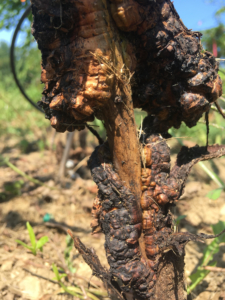
Fig 14 Early spring frost/freeze events can damage a kiwiberry vine in a number of ways. While a vine can often recover from dieback of frost-susceptible leaf and/or flower tissue via secondary flushes of buds, more substantial damage can occur due to early season sap flow, like the spectacular trunk blow-out shown here. Some varieties are far less prone to such damage than others, and the NHAES breeding program selects strongly for this trait.

